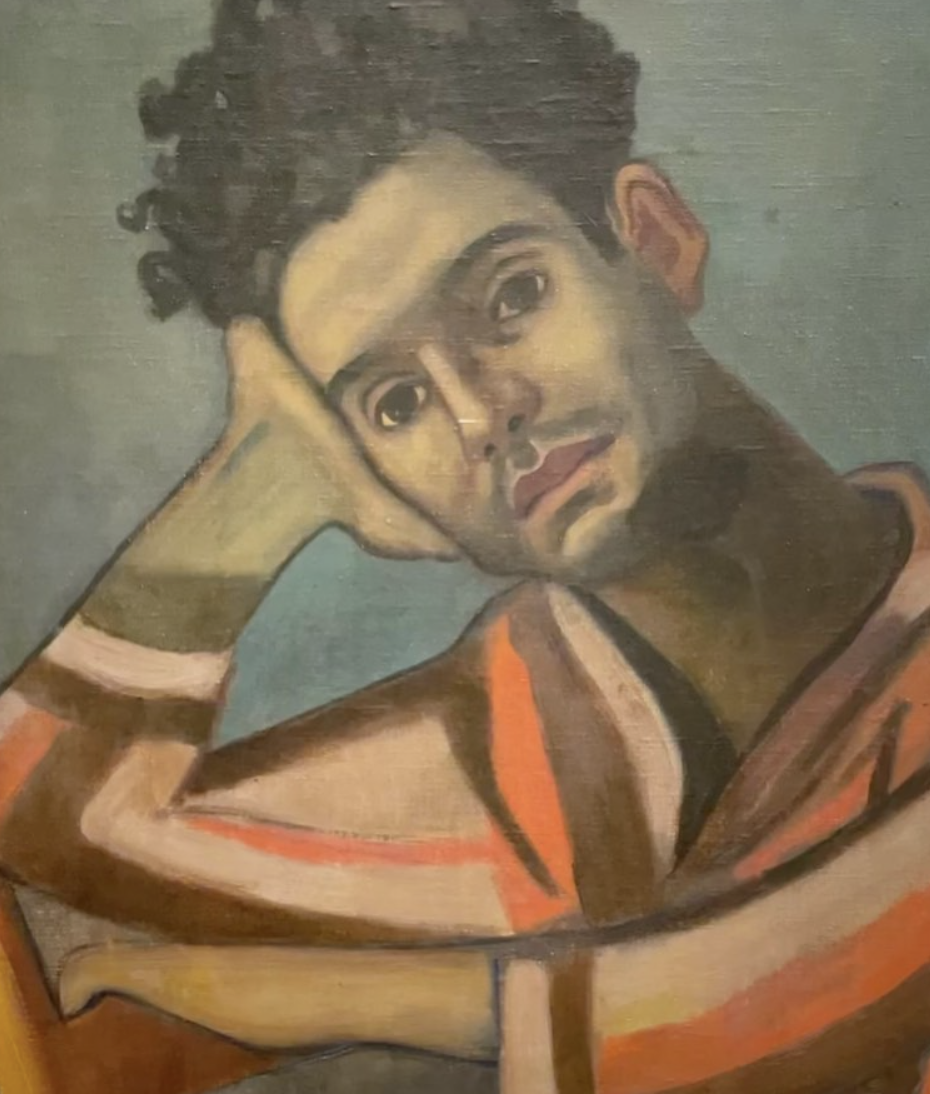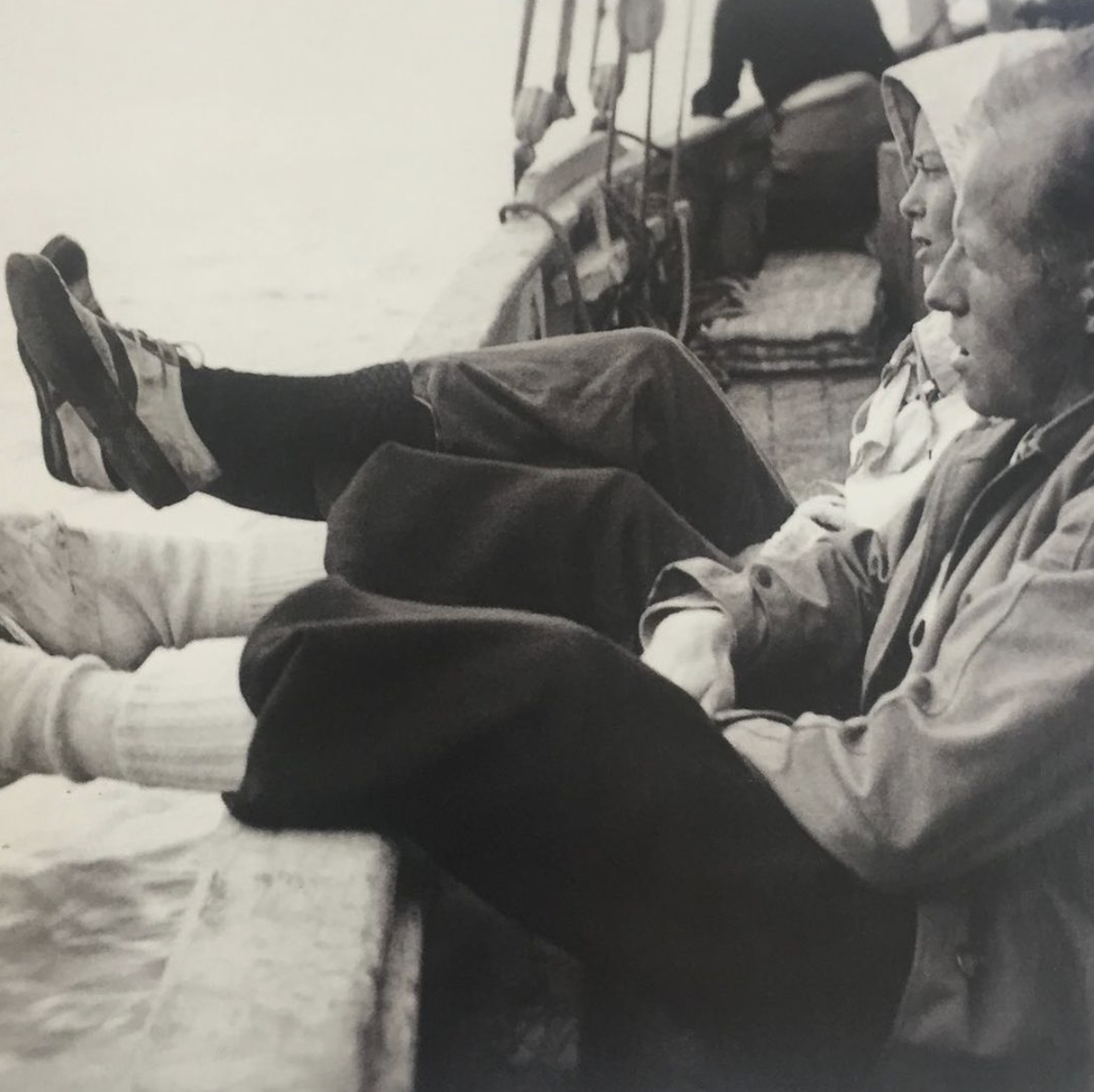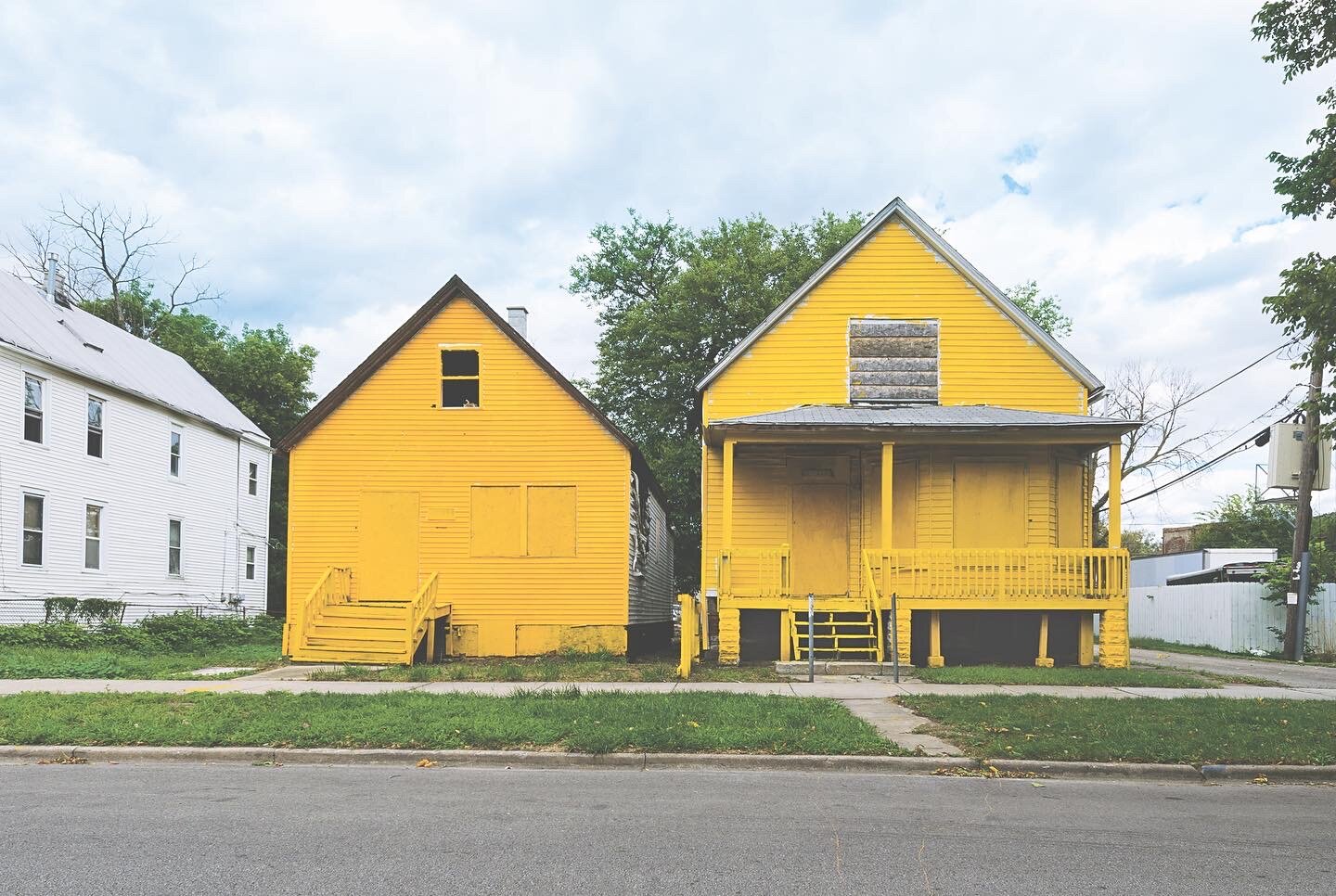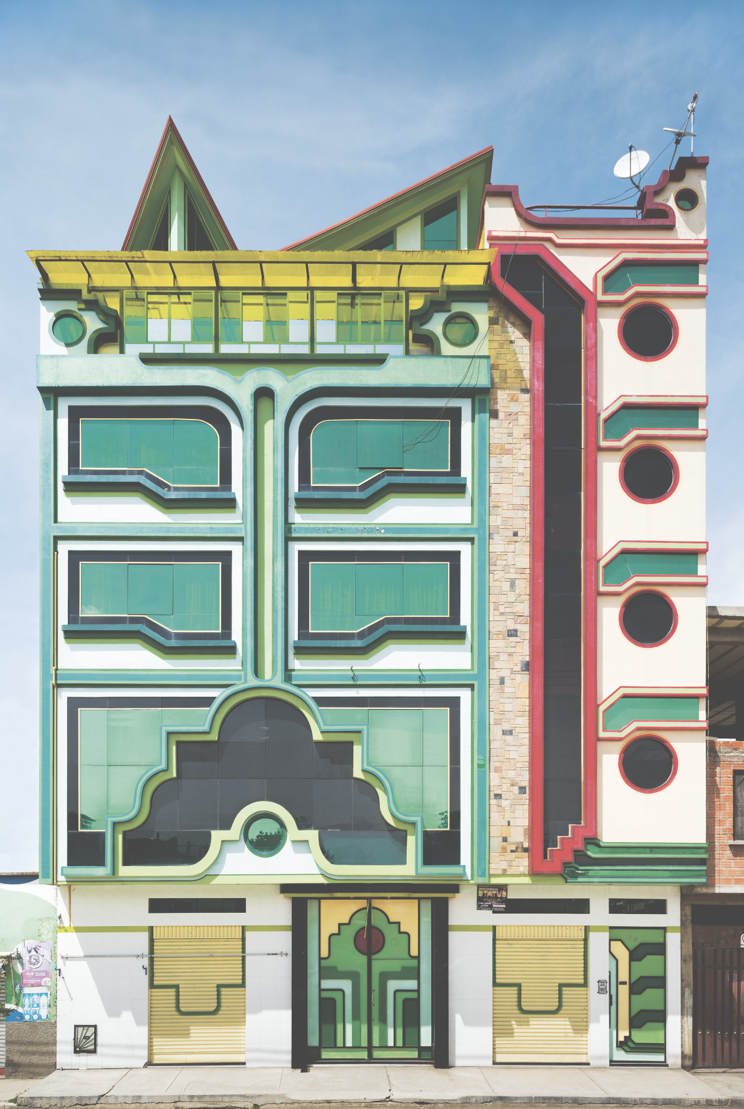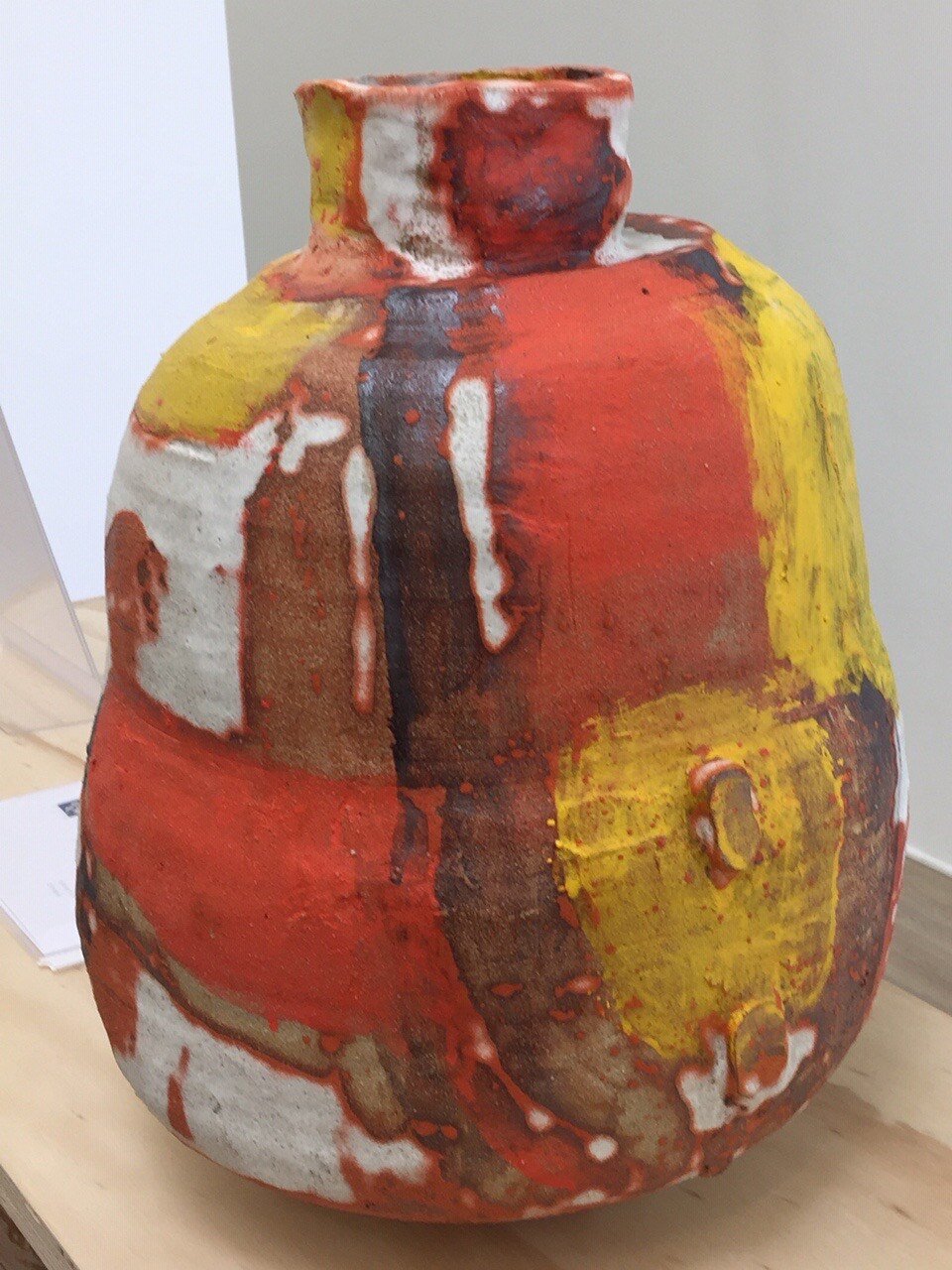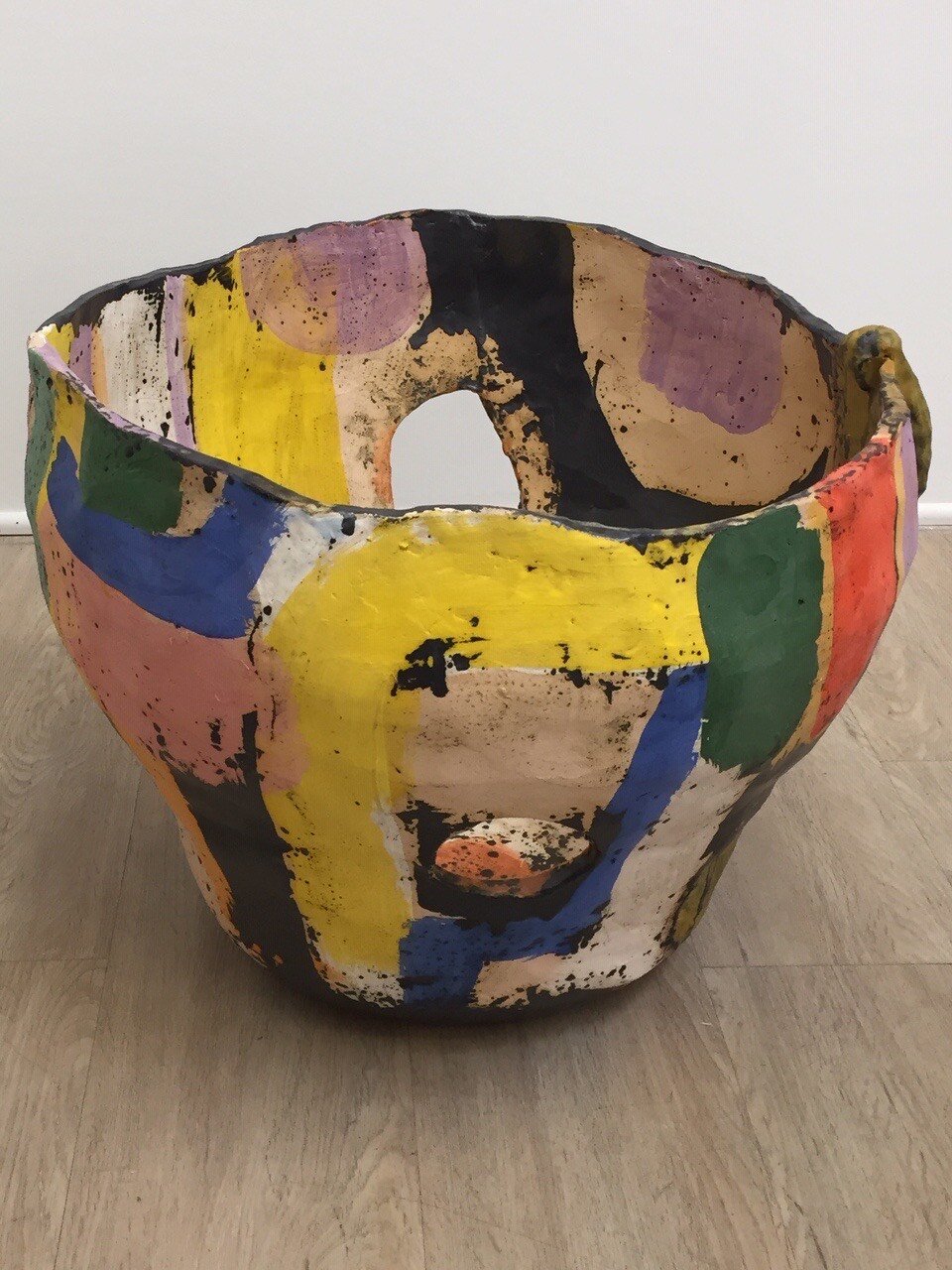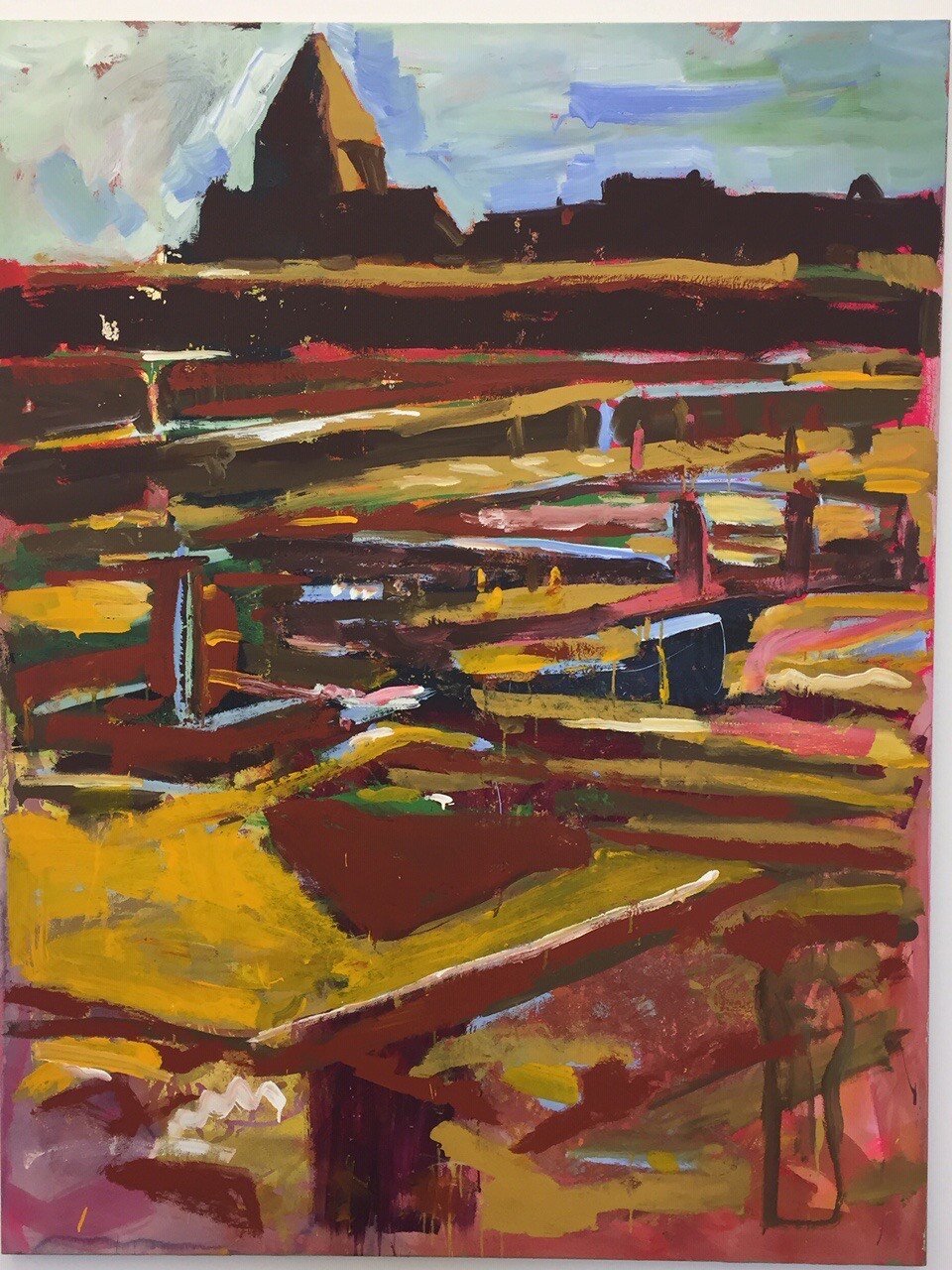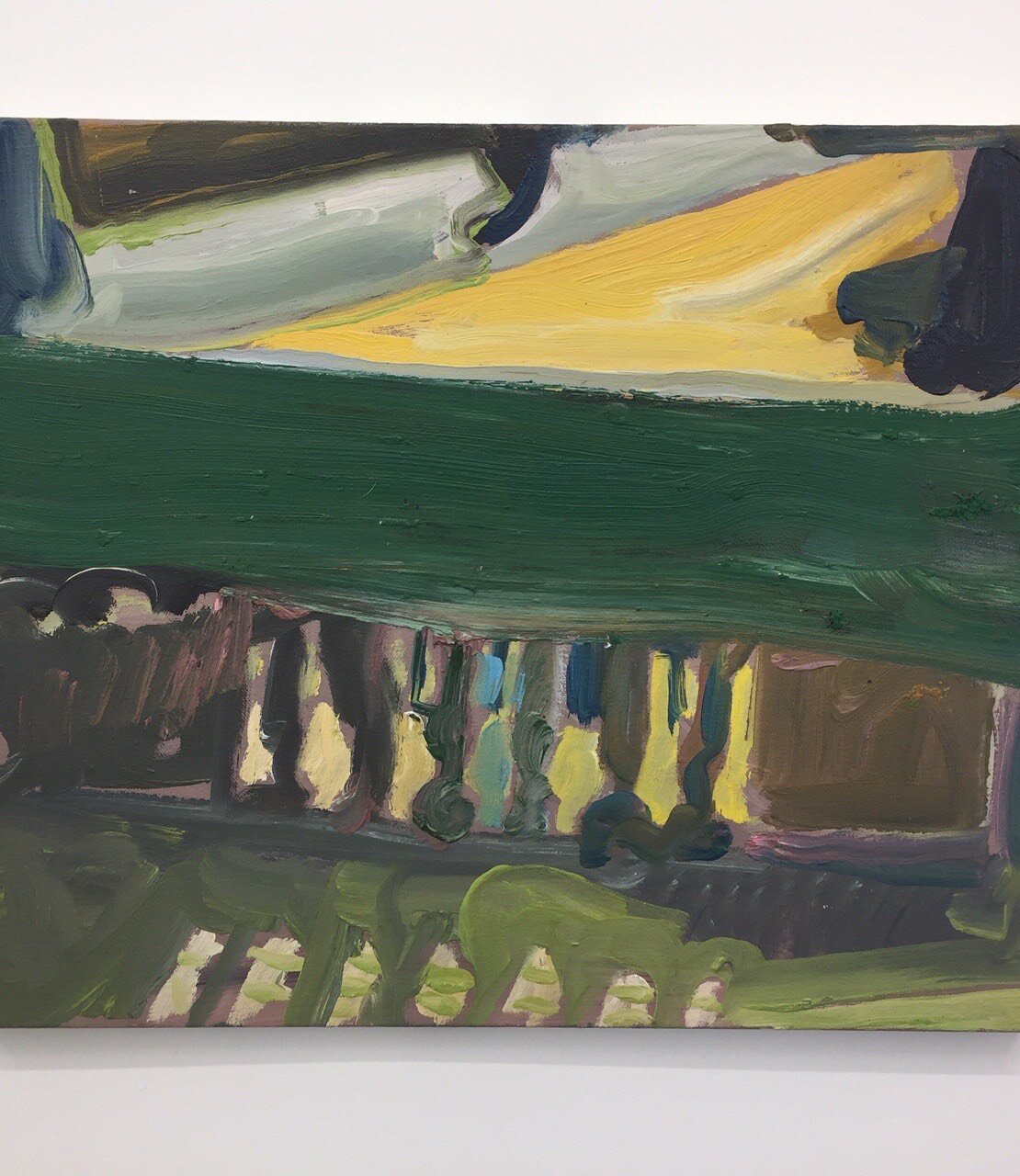Though I had seen many images from the Alice Neel show at the Met, I was not prepared for the breadth and depth of the actual exhibition. Fair warning: even with a ticket, in mid week, in the morning, the line was at least 30-45 minutes to enter. It is beyond worth it.
The exhibition provokes questions about her biography. If you go to aliceneel.com, you will be able to see marvelous photographs of her and her world and also learn the more granular details.
Though we are often warned not to conflate the life and the work, with Neel, it's impossible not to be struck by the number of marriages she tore apart, and the number of relationships of her own that seemed fungible. Neel felt free to pursue her passions, be they artistic or romantic. Some blew up on her. Her relationship with Carlos Enriquez ended in abandonment along with the death of one daughter and the hijacking of another and her subsequent hospitalization for a nervous breakdown. Hot tempered seaman Kenneth Doolittle burned and destroyed a large archive of her art. John Rothschild left his wife for her, but she did not commit to him. Perhaps he reminded her too much of her more conventional Pennsylvania background. Jose Negron, a salsa band leader, pictured here in 1936, left his wife for Neel but interestingly, she ended up using her as a subject.
Not long after they got together, they moved to Spanish Harlem and she began the prolific, clear eyed rendering of her friends and neighbors that is such an important part of the exhibition. They had a child, Richard, together (originally called Neel!) but Negron moved on a few years later to another woman.
The libertinage of the age went along with the politics, and the artistic milieu. Inevitably, there was collateral damage. But at the Met, we see the affection she once bore for her lovers in her indelible portraits. West coasters take heart: the show comes to the deYoung in 2022.
Jose1936, Estate of Alice Neel
Dana Schutz's First Show at Zwirner
There is nothing I anticipate more in contemporary art than seeing a new drop of work by artist Dana Schutz. I have followed her career and written about her. But nothing replaces the explosion of delight, intrigue and emotion that seeing the works in person evokes. This painting is so complex and filled with allusions and references that it is something worth studying up close. Alas I could not extend my stay in NY to see the new works at Frieze New York, but I am happy to be able to share this one with you and get your reactions. Entitled The Arts and rife with collectors with pearls and baseball bats scrambling over each other to get at the works of art, critics, dealers ( this is Dana’s first show with her new mega gallery Zwirner) and a general melee, perhaps this is Dana’s wry take on what the scene at the first art fair to emerge during Covid will be.
Dana Schutz, The Arts, 2021 © Dana Schutz. Courtesy the artist and David Zwirner.
An exhibition about life in America
New York is awash in museums and galleries grappling with not just the past year but many years of suffering by black citizens. Grief and Grievance: Art and Mourning in America at The New Museum makes those experiences both plain and exalted. So many moving, vibrant works are in the show it’s best just to push you along to see it if you can and discover its endless examples of the obstacles of just trying to live a normal life, to get through the day. One arresting image from Arthur Jafa’s ground floor video “Love is the Message; the Message is Death” is of a mother after she is pulled over by the police, backing up with her hands up and asking “what did I do wrong>” as one of her young terrified children slowly exits the car. Her fear for them, her incomprehension, the sheer brutality of it will stay with me forever.
Deluge IIs Painting Holds Truth Today
In all the turmoil about Philip Guston’s Klan paintings and the radical decision to postpone his retrospective I had forgotten this marvelous painting at MoMA which stands out there even among all the other standouts and classics. Deluge II painted it in 1975 at another point of inflection in the world (war /AIDS/drugs et al) felt so spot on for today’s pandemic deluge with its disembodied, muted heads, floating shoe and leg debris, and violent reddish hues. It reminded me of another famous painting which once hung at MoMA in the 70’s which also bespoke the horrors of war but in the end represented a wholly uncontrollable force visited upon an unsuspecting population, Picasso’s cry of rage and pain, Guernica.
Salon 94 Shows Early Saint Phalle
I made it to the stunning new gallery space for Salon 94 just as the Niki de Saint Phalle pieces were being prepared for their crates. What a joyful and rich display of this talented artist’s work. It felt like the gallery had met the moment joining these pieces in a long overdue tribute which showed the enormous energy and serious craftsmanship that even her mini Nanas demanded. Saint Phalle launched her own production line to fund her art- dreading ceding power to any funders or committees. While she was reviled for this in her lifetime, considered too crass and commercial, she took control of her output as a way to make more art. And they look spritely and gay and much like Calder’s circus, they were a path to other opportunities.
Lygia Pape Finds Inspiration in Brazil
I thought this image from the upcoming Lygia Pape show at Hauser & Wirth LA opening this weekend was apt for Earth Day.
Like Brazilian architect Lina Bo Bardi, more or less her contemporary, Lygia Pape found in the indigenous populations of Brazil a new way of aligning her practice. Though a member of the Concrete and then Neo Concrete movements in Brazil which favored the primacy of the viewer and interaction with a work of art, there is some Surrealism and even Pop in Pape's work. The body and its intersection with geometry is apparent in her later, more three dimensional work.
The Tumpinamba tribe which used red feathers in tribal ceremonies, apparently devoured their captives not for sustenance but to absorb the spiritual capacities of the "other". Pape seems to have absorbed other cultures in the same way, digesting them to see how others interpreted the world.
This red-feathered ball with the hand reaching out from inside, reminded me somehow of the old Negro Spiritual, "He's got the whole world in his hands." Only this time, SHES got the whole world in her hands. I look forward to seeing the show.
Memoria Tupinamba 2000 courtesy Projeto Lydia Pape and Hauser & Wirth
Memories of Charlotte Perriand
I love this photograph of Charlotte Perriand, French designer and architect who broke the mold as a modernist disciple of Le Corbusier and his cousin, Pierre Jeanneret, who was second in command at their studio in Paris where Charlotte brought "the brisk mountain air".
Not enough has been written--except by Perriand herself in her lovely and detailed memoir--about the importance of this relationship in her life. Pierre was her boon companion in the outdoors she so loved. Hiking, backpacking with their tents, Quaker Oats and sardines, collecting rocks and shells together, they forged a relationship that went far beyond the design of the famous lounge chair. In Normandy, in Greece, in the Savoie, they foraged, filled their backpacks with pebbles, lay on the beaches nude in the sun. They communed together with the earth and the sky.
On his boat they went to Yugoslavia. A priest was on board, and she was afraid she couldn't sunbathe nude as was her custom. At a conference of famous architects they escaped and went mountain climbing.
The cousins were very close, but Corbu became jealous of Pierre. He was supremely competitive even though he had been the one to suggest the relationship. Corbu as a matchmaker: it's not something generally put on his CV. Charlotte described Pierre as warmhearted, understanding, modest, self-effacing, like a brother to everyone. Everything that Corbu was not. One Christmas, spending it with Pierre's welcoming family, she borrowed a dress from his sister.
He gave her the wood for her first free form table design. They designed furniture for Knoll together even after their split as a couple. Though Charlotte eventually moved on, she never forgot her old lovers, gathering up people as she gathered up objects, holding them close. She is the kind of guiding spirit we need during Earth Week, one who understood that nature was as important as the built environment and that they must be welded together.
Max Beckmann and Mies Van der Rohe: Degenerate friends?
The story behind this work by Max Beckmann fascinated me. A group of Mies van der Rohe's friends and colleagues got together in 1934 to give this lush, seductive painting to Mies for his birthday in 1936 because, allegedly, it was too expensive for him to buy. Beckman chose the work and reduced the price. Mies hung it in his Berlin apartment in plain sight but when he moved to the US, he kept it in bedroom for fear of the puritanical American sensibility. Mies, nevertheless, was already known as something of a ladies man.
A few years after this, Beckmann himself fled to Amsterdam after his work was shown in the Nazi's 'degenerate art' show.
In 1944, Beckmann would paint Mies in a double portrait. A year after that, Mies began his infamous quasi-professional, quasi -personal, eventually combustible liaison with his Chicago client Edith Farnsworth. A few years later, Beckmann had also moved to the US and was teaching in Saint Louis after Philip Guston, who was an admirer of Beckmann's, had taken a leave from his post.
On his way to see one of his paintings at the Met, Beckmann died on the corner of 69th and Central Park West of a heart attack in New York. Mies died from smoking too much. Guston also died of a heart attack, probably not helped from smoking too much.
So many connections, and missed connections, and alas cigarettes, among the great artists of the 20th century.
Max Beckmann, Figure with Mask, 1934, collection Guggenheim Museum, partial gift Georgia van der Rohe.
Madame X and Black Duck: Separated at birth?
In 1884 John Singer Sargent, eager to make his mark in Paris, finally convinced Virginie Gautreau, one of the Edith Wharton-esque American expat beauties who had also made her way in France in a marriage to a wealthy banker, to sit for him. She was already semi notorious for her beauty and her affairs. All this was catnip to Sargent who understood she would be the ideal subject to catapult him from well regarded to famous. His painting, eventually known at Madame X, did indeed do the trick.
Her white skin (reportedly enhanced by lavender powder), her black slip of an evening gown in one early version slipping off her shoulder, her retrousse nose and her dynamic standing pose combined to make this portrait dominate any room in which it resided. Sargent kept it for many years before he allow dealer Pierre Rosenberg to take it off his hands.
A half-century later, Marsden Hartley, the spiritual, largely closeted gay painter of colorful landscapes and abstracted coded German symbolism returned from Europe to his native Maine where he finally found a measure of peace in nature and a love relationship with a young fisherman.
His painting in 1941 of the Black Duck No 1 may not have had the same sensational reception as Sargent's Madame X, but it feels equally erotic, and side by side they form an intriguing, separated-at-birth pair.
Madame X, John Singer Sargent, Metropolitan Museum of Art
Black Duck No 1, Detroit Institute of the Arts
Berthe Morisot and Manet
Image credit: @clevelandmuseumofart
There are so many affecting things about Manet’s portrait of his sister-in-law, painter Berthe Morisot, begun in 1869. It's winter. Morisot is wearing a fur coat and muff and a violet hat of velvet trimmed with grey plumes. Manet painted her 11 times over many seasons and with many hats. He was fashionable and so was she. He was famously popular with the ladies and is the one who introduced her to his brother.
She was a supposed great-niece of Fragonard's so painting was already in the family. They met copying paintings at the Louvre. But Morisot in fact was the one who introduced Manet to Degas, Monet, Renoir and Cezanne among others in her circle. Her plein air painting had a great influence on him.
At the time of the portrait, Morisot was still mostly working in watercolors. But at the age of 23 she was accepted at the career defining Salon in 1864. Yet there is a certain tentativeness, an almost nervous energy one can still see five years later. Morisot had trouble convincing her parents to let her pursue a serious career.
Violet was a color Manet associated with her. The touches of violet become still more pronounced in a well loved later painting he did of her with a bouquet of violets after her father had died. Though this portrait is a lot tamer than the Dejeuner sur L'Herbe or the Olympia which had made his reputation, it still has the intensity of that work. It has a dynamic, fleeting quality that was certainly impressionistic, yet had hallmarks of his signature style where figures emerged from the black. He kept this portrait throughout his life.
Dancing Through Another Round
Body language is everything right now. Did you feel like dancing yesterday? We had a power failure in LA --so common now, between fires and earthquakes we have rolling blackouts--so I couldn't watch the Inaugural show--but I felt like @theofficialmads, the tall, hunky, gorgeous Danish actor in Another Round, the new film from Thomas Vinterberg. I wanted to bust a move.
The film is a masterpiece of understatement and cool even as the four male protagonists-teachers in a secondary school--have their individual meltdowns. Ostensibly to see if a theory about maintaining a certain blood alcohol level they read about will hold water(it does, and then it spectacularly doesn't), it's really about pinning your hopes on an external force to ramp your creativity, your intelligence, your grace, whatever it is that you haven't got going as much as you might wish. Guess how that turns out.
The guys try to coax Martin (Mikkelsen) through the whole film to get up and dance. They dance. But Martin resists. Then at the very end when things have gone from bad to worse in his marriage, there is finally a ray of hope, and he bursts into spontaneous movement on a pier surrounded by his graduating students (all wonderful).
Mikkelsen was trained as a @marthagrahamdance dancer--which seems to be how I am seeing the world this week--and that ability to express things with your middle is on full display in the film. Once cast as a villain, he now seems the embodiment of male angst and joy.
Remembering David Park
Yesterday, via @janet_bishop and the @sfmoma, a talk about David Park, the Bay Area figurative painter, gave new insights into his beautiful body of work (cut short by cancer). But: the most amazing part was that his daughter Helen, and Gretchen, the daughter of Richard Diebenkorn, his student, mentee and eventual best friend, also participated with first hand memories.
Like the fact that Helen called her parents by their first names, David and DeeDee (her name was Lydia). And the fact that a head of Lydia once had a self portrait of Park underneath.
The @kalamazooinstituteofarts, one stop on the Park exhibition tour, held a conference showing how much Park had influenced a number of important Black artists.
Because the artist died so young, his career has been in something of an eclipse. But if you ask any figurative painter (like Dana Schutz), often they will extoll his painting. He abandoned abstract expressionism when it was all the rage and went his own way, finding color, lush brushwork, impasto and humans more to his taste.
He painted from memory, not from photographs however. So there is something haunting and so very personal in each rendering.
Park himself was most famously photographed by his friend and renowned San Francisco portraitist Imogen Cunningham, with whom he traded a lovely portrait that captures her whimsical appearance.
The other thrill was that artist Wayne Thiebaud, now 100 years old, appeared live and spoke about how much he admired Park's work. You can perhaps see him up in the corner there as he spoke.
Lemons
There is the saying that we must make lemonade out of lemons. I'm eager to see how the new year unfolds and I wish more than anything for recent horrific events to produce a sweeter New Year.
But this gorgeous watercolor of a misshapen lemon from the Victoria & Albert Museum is rather more where I see us: grown wild, our core DNA somehow corrupted. It was part of something called "The Paper Museum" assembled by the 17th century Roman antiquarian and collector Cassiano dal Pozzo who was a member of Europe's first modern scientific academy in Rome. It was owned afterwards by the Pope, and eventually the Queen among others. This piquant image was perhaps by Vincenzo Leonardi an artist who did many of Cassiano's encyclopedic library of renderings of fruits and plants.
Cassiano was most intrigued by abnormality in animals and plants and this specimen was corrupted by a mite on the bud of a flower. (Ugli fruits are all about this kind of corruption) But rather than get discouraged, he embraced abnormality as a method of understanding was normal was. Some theories had it that a youth (eg the 'fingers') had transformed magically into a tree.
My backyard lemon tree has faded more times than I can count, but each time it goes dormant, I know it will return--it's youthful, fecund spirit indomitable. I am trying to imbue myself with Cassiano's belief system: our abnormal years will help us prize and return to more peaceful and less pernicious norms.
Radical Architecture of the Future
In times like these, when the very citadels of power, classic structures that represent endurance and impermeability are breached (see, the reality show the Capitol), it is hard to imagine what buildings, or indeed the built environment can do to save us.
@beatricegalilee, a former Metropolitan Museum curator, current doyenne of @TheWorldAround summit coming next week at the @Guggenheim (where there is already @rem.koolhaas's around-the-ramps nod to similar questions of rebirth and durability, Countryside) takes a stab at figuring all this out in her new uber compendium, Radical Architecture of the Future from @phaidonsnaps. Grazing as Koolhaas does over film, installations journalism, apps, and VR, the book is a good primer into what architects, designers, filmmakers and researchers are or have been thinking about. In highlighting 79 completed projects by visionaries, insiders, radicals, breakthroughs and masterminds, she aims to give an overview of possibilities. Though I've seen many of the projects before at various design fairs and biennials and written about some, it's great fun to see the aggregate of what these geniuses have been getting up to.
Cross disciplinary thinking is now endemic to all professions not just design and architecture (hello: writers, poets, filmmakers, tech gurus, health and wellness guides), but a building or a street has more 'there-there' than most other fields, a permanence that gives the work of these creators a life span that many other fields just cannot claim. (However: I saw the @marchingcobrasofny in their last performance in NY. This is my kind of radical architecture. And @unnoficialkazuyosejima's yellow commuter train! And @BekaLemoine’s original films)
Once upon a time I was a devotee of Superstudio whose radical thinking is eerily similar to projects in this book. These hip Italian iconoclasts were already warning us to be prepared to give up our washing machines and jewelry in the sixties, to live on a grid but off the grid, to find love and happiness without possessions in a new communal, environmentally conscious way. Sixty years later, we are still trying to figure this out.
Ammonite
Coming not long after the lyrical, spare but haunting Celine Sciamma film, Portrait of a Lady on Fire, which set a very high bar, Ammonite directed by Francis Lee and starring the more well known actors Kate Winslet and Saoirse Ronan, could not help but be compared in this newish mini genre of period lesbian filmmaking by the sea. And yet it stands firmly on its own.
Mary (Winslet) is an intense, determined, quietly raging sea fossil hunter who lives with her aging mother in the harsh seaside town of Lyme Regis having been canonized with an early ichthyosaur discovery enshrined in the British museum.(The script is loosely based on the true life story of paleontologist Mary Anning) The life of the spinster who has dedicated herself to her self taught work, alas now mostly touristic to make ends meet, is upended when the young, wealthy Charlotte is entrusted to her care by her neglectful husband. Ostensibly to teach her something of the trade while taking the sea air, Mary becomes a full time caretaker when she falls ill. Therein ensues the at first tentative, then wildly passionate, hermetic love affair between the two.
Though there aren't surprises in the narrative, the acting and the respectful filmmaking are indeed sublime, and my question about the money-shot lovemaking scene arises not for its delicious eroticism but for its 21st century abandonment.
Winslet, who has slowly transformed from beautiful leading lady into a character actress (see also the 2019 Blackbird) is entirely believable and Ronan continues to find her way to a very diverse, substantial career. The film is welcome as a serious, elegant, sensual counterpoint to world events, a lockdown of another kind.
Robert Storr's Writings on Art
Robert Storr's collection of his Writings on Art 1980-2005, the first of a projected two-volume anthology, is enough to want to make any writer about art or culture roll over and give up. No way to compete. Storr, whose work I have long admired, is herein seen as not only an advocate of artists but as a communicator of the highest order. As an artist himself who worked at many trades in many locations before settling into a paying gig of criticism( he calls himself "The Accidental Critic") is at once clear eyed and fine grained. He debunks the idea of it being a 'career", and with that I am in full sympathy. Anyone who goes into writing about arts and culture needs to have their eyes wide shut.
A great aunt, then Bill Rubin, then artists like Christo, Frank Stella, Oldenburg, Jasper Johns and Siquieros, gave him an up close view. Lee Krasner gave him his inaugural lesson in the "sexual politics of art". I was only sorry to not know even more about Storr's personal history and his interactions with artists. Included are essays--a marvel of information and insight-- and excellent illustrations of. among others, the work of Louise Bourgeois,Peter Saul, Yvonne Rainer, Jean-Miche lBasquiat, Ilya Kabakov, Carroll Dunham, Arshile Gorky, and Philip Guston, whose work he championed early on.
When I wrote about MoMA last year for AirMail, I spent many many virtual hours in the archives reading interviews with curators, donors and staff. Storr's oral history was among the most candid and refreshing. He was brought on by Kirk Varnedoe to make more of a place for contemporary art at the museum, and his unvarnished reflections of his employ there are fully accessible at the MoMA database. This candid photograph of him in his office shows the enormous volume of his daily intake--which is fully reflected in these essays.
Ceiling and Waterfall at the Noguchi Museum
Photo by Alexandre Georges © The Isamu Noguchi Foundation and Garden Museum, New York / ARS.
This 1957 photograph of Ceiling and Waterfall by Isamu Noguchi, now de-installed and property of the Noguchi Museum in Queens represents just one more example of art installations around the country being destroyed in the name of the new. What struck me was: this building, though technically part of Brookfield Property holdings was until quite recently part of the real estate empire of Jared Kushner and family-- who wanted to tear it down and apparently made a fiasco of the investment.
I remember 666Fifth as a building that was quite chic, had screening rooms and important #Hollywood companies and others--a cigar club up top and a restaurant, Top of the Sixes, that was almost in the league of the Rainbow Room. When Brookfield acquired it, there had already been vast and apparently not so happy renovations.
While I am happy for the Noguchi Museum to have acquired it, and perhaps they will find a more welcome public home for it, I cannot help but think about the artist, who was so careful and deliberate in his choices, and utterly site specific.
Roger Herman's French Paintings
Roger Herman's new show at @prazdelavallade is called My French Paintings but that doesn't mean that's everything the exhibition contains. On a quiet Saturday, when LA has now ghosted almost everything around, this lively, colorful show is a tonic, a sight for impoverished eyes, a blessing, even.
Herman is known both as a beloved, longstanding professor of art at UCLA but also a practicing artist whose work spans decades of experimentation and delight. German by birth, a Frenchman in his cool, seductive personality (and the pronunciation of his name, it's Ro-jay) and finally fully an Angeleno by self-definition, he came to the US, first to San Francisico, a fan of the work of David Park--who had already died-- (a recent retrospective of this hero of Bay Area Figurative at @SFMoMA all too evanescent) and Richard Diebenkorn--who was by then in LA. Where he landed eventually too--enamored of its anti history, its openess, a freedom he felt. Migrating from this Ocean Park-ness of semi-abstraction that reminds me also of Frank Auerbach, to pattern and decoration (as if Lari Pittman had taken acid), to the photo-based haunted qualities of Gerhard Richter, in the end, one hates to compare him to anything but himself.
My coup de foudre is for the pots. I was gifted one small one that had the sly, erotic etchings he became known for, but have now grown into full blown, colorful thin skinned vessels into which he has poured joy and life. I long to be able to buy one of these babies, but in the interim, there are still copies left of his limited edition signed book at @arcanabooks which will just have to do.
More Rozier
Continuing in its restoration of the work of Jacques Rozier (see my story for Airmail on his Bardot film), the @CinemathequeFr has just loaded a charming early Jacques Rozier short, Blue Jeans, made when he was just 30, which showcases this early member of the Nouvelle Vague's insouciant take on life, love, and the Cote d’Azur. It's available for free on their Henri (named after the founder, Henri Langlois) channel, with English titles along with many other jewels.
This time we find ourselves with two young, gorgeous, hotshot drageurs (the French word for pickup artists is just so much more efficient) who wear tucked in white shirts and blue jeans (no longer called blue, but then, only blue, appropriated from the farm) who don't consider a day's work done until they have found some lovelies to share the night with. Hunting for prey on their Vespas in and around Cannes, they happen upon two wasp-waisted, short shorted, high heeled wearing beauties who fit the bill and after some to and fro, hop aboard to trip the life fantastic. The beach is the scene of their making out, their dancing (the chacha!) and eventually their come-uppance. Actual work plays no role, being on the make, without money, turns out to be a full-time pursuit. All this to a Cuban soundtrack that lifts the spirits. Jean Luc Godard wrote, " A buoyant short, young and beautiful like the body of a 20 year old as Arthur Rimbaud has described it."
Richard Neutra
Julius Shulman © J. Paul Getty Trust. Getty Research Institute, Los Angeles
Richard Neutra, the Viennese architect who became the storied emigre to Los Angeles did not just design fab Palm Springs houses for the likes of Edgar Kaufman Jr (now on the market for 25 million), he also thought about the education of young children, and what suited them best. (When Neutra's LA office eventually closed, there was a tag sale. I hurried and bought two keepsakes: a map, and the office radio which I like to imagine Neutra tuning to Mozart)
Now that the subject of elementary schooling is writ large during the pandemic as distance learning is very challenging for the young'ns, Neutra's LA Corona Avenue School, here represented in an image by architectural photographer Julius Shulman in 1953, is more than prescient. It followed in the steps of open air schools in Germany, France and throughout Europe designed at first for tubercular and ill children, but then adopted as a healthy way of pedagogy. (see images in the thirties of the Ecole de Suresnes in France above)
In LA of course, the absence of cold weather eventually made these designs more ubiquitous but the large sliding glass doors which were also featured in Neutra's (and Eames et al) domestic architecture brought the outside in and were adopted in less temperate climates.
I look to the current generation of forward thinking architects to revisit some of these buildings and see if they can figure out how to keep children safe, while learning and socializing with their pals during these most challenging times.
